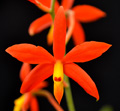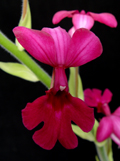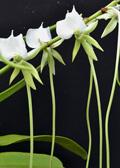Orchids
By, Emily Wentzel
Plant Science 211, NDSU, Fall 2011
Home | Characteristics | Guidelines for Planting | References
Characteristics
 |
 |
 |
| Orange Orchid | Pink Orchid | White Orchid |
Most orchids are grown for their beautiful flowers, but the seedpods of the Vanilla orchid provide the popular flavoring. Most of the orchids commonly found for sale are hybrids that have been created specifically for their flowers and ease of care in homes and offices.
For centuries, people all over the world have fallen in love with their flowers. They have bright colors, unique shapes that you can’t find anywhere else, and enchanting smells have evolved to attract pollinators. Many have a relationship with a single type of insect or bird that can pollinate their flowers.
Orchids can be found in the equatorial tropics, the arctic tundra, and everywhere in between. Unlike most plants, they do not grow in soil, but high above ground in their natural environment. Their roots attach to trees or rocks where they capture moisture and nutrients that wash over them in the rainforest. Most cultivated orchids are native to the tropics. Because these tropical orchids usually grow high in the trees, rather than on the forest floor, they are accustomed to good air circulation and plenty of light. They prefer a 12-hour day, all year-round, and require a high intensity of light.
Orchids are usually grouped into two broad categories that characterize their growth habits monopodial and sympodial. Monopodial orchids have a single, upright stem, with and opposite leaf arraignment. The flower stem appears from the base of the uppermost leaves. Examples of orchids with this growth habit include the phalaenopsis and vandas. The more common and well known growth habit is sympodial. These orchids grow horizontally, sending out new shoots from the old rhizome. They things called pseudobulbs, which are swollen shoots that store water and nutrients to help the plant survive long droughts. Sympodial orchids include cattleya, cymbidium, oncidium and dendrobium.